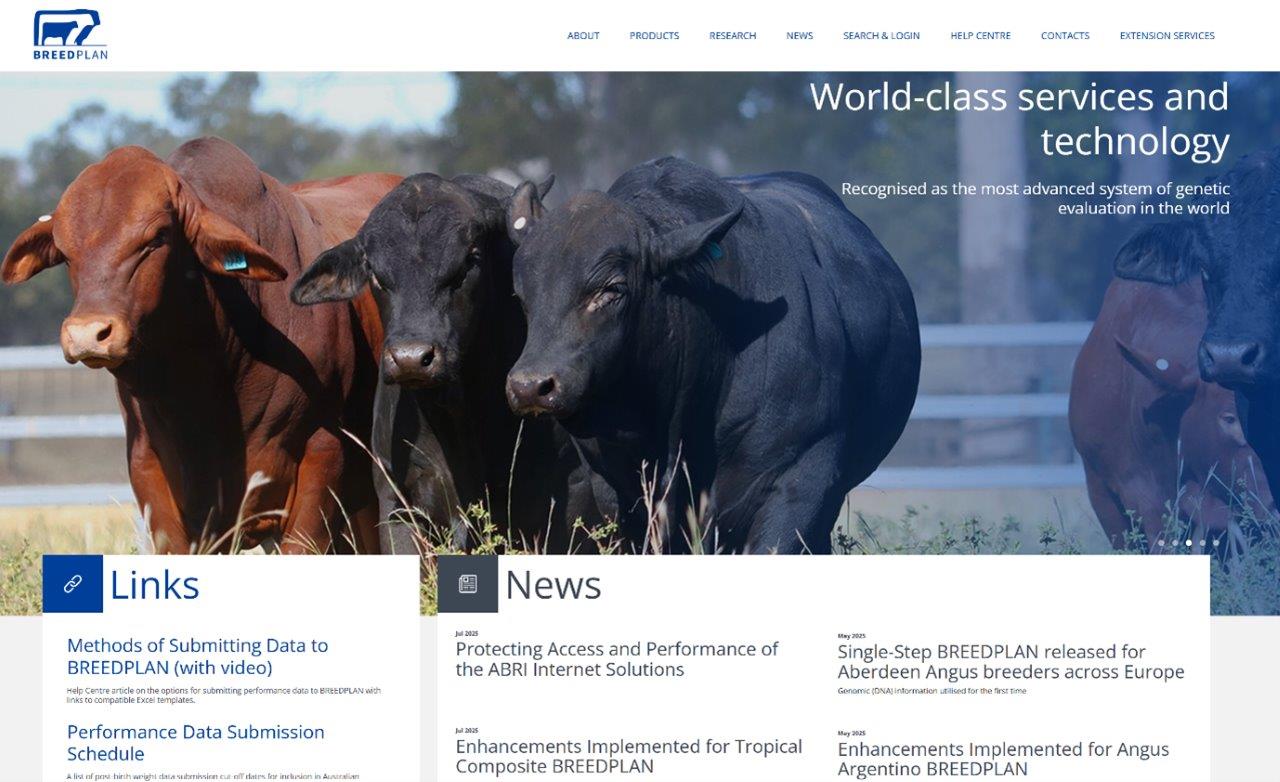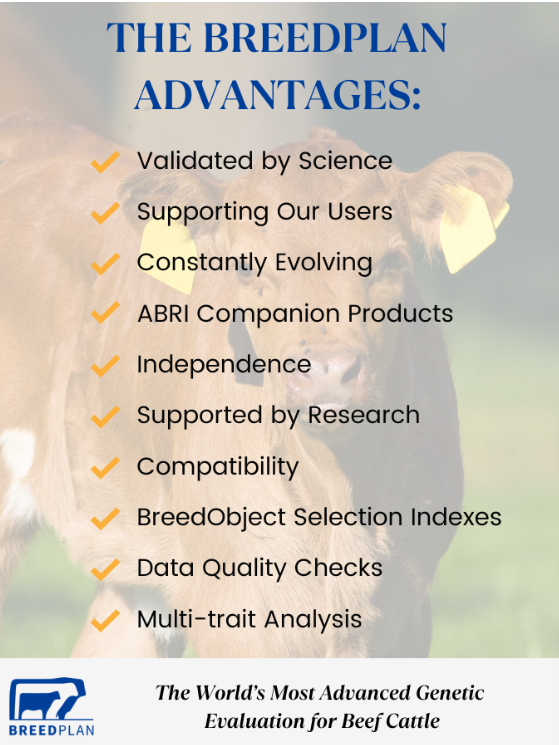BREEDPLAN explained

BREEDPLAN offers all beef cattle breeders the potential to accelerate genetic progress in their herds and to provide objective information on stock they sell. Developed in Australia, BREEDPLAN is now used in many of the world’s prominent beef producing countries.
Provided by the Agricultural Business Research Institute (ABRI) to both Australian and international clients, BREEDPLAN represents the most widely used genetic evaluation service for beef cattle internationally. Over 60 different BREEDPLAN evaluations have been developed, representing over 14 million animals, almost 40 beef cattle breeds and at least 100 breed associations distributed across 14 countries.
BREEDPLAN uses an advanced modern genetic evaluation system (based on Best Linear Unbiased Prediction (BLUP) technology incorporating multi-trait analysis procedures) to produce Estimated Breeding Values (EBVs) for recorded cattle across a range of important production traits. While BREEDPLAN technology can be used at a number of levels, those wishing to join a BREEDPLAN analysis typically do so via a breed society/association (or breeding group). Within a breed society analysis, members are able to compare BREEDPLAN EBVs between herds. International genetic evaluations are also common, where breed societies from a number of countries pool their data for analysis (e.g. TransTasman BREEDPLAN analyses). There are also options available outside of the breed society structure (e.g. for commercial breeders or composite and crossbred herds).
Included in the calculation of EBVs for each animal is the animals own pedigree and performance information, the performance of all known relatives, the performance of any progeny that the animal may have, the known relationship between traits, and any genomic information that may be available. Since 2017, a number of BREEDPLAN analyses have moved to incorporate genomic information in the form of Single-Step BREEDPLAN.
EBVs are expressed in the actual units of measurement. For example, 200 Day Growth EBVs are reported in kilograms, while Rib Fat EBVs are reported in millimetres of fat. EBVs are reported as being positive or negative, relative to a historic benchmark for each trait. More importantly, breed average EBVs and percentile bands allow beef producers to rank animals relative to the current level of genetics within the population being analysed.
BREEDPLAN – A BREEDPLAN Guide to Interpreting EBVs (with video)
How do I join BREEDPLAN?
Prerequisites
In order to performance record your animals with BREEDPLAN, there are generally three requirements:
- You must be a member of your breed society
- Your breed society must be running a BREEDPLAN analysis
- The calves which you wish to submit performance information/receive EBVs for must be registered with your breed society
Note: BREEDPLAN does offer within-herd genetic evaluation services to producers who do not record with a breed society. For details, please contact staff at BREEDPLAN.
How to join
The first step to joining BREEDPLAN is to fill out and return a BREEDPLAN enrolment form. BREEDPLAN enrolment forms can be obtained by contacting staff at BREEDPLAN or your breed society, who will send you a BREEDPLAN enquiry kit. Alternatively you can download a BREEDPLAN enrolment form by searching the relevant breed name and “Enrolment Form” in the Help Centre.
Once you have completed your enrolment form, simply email to the relevant breed email address, or mail to the address listed on the enrolment form. This will be either the BREEDPLAN office or your relevant breed society office.
Once your enrolment form has been received and processed by the BREEDPLAN office, the staff will email you an enrolment kit which includes everything you’ll need to get you started on performance recording with BREEDPLAN.
Fees
Some breed societies require upfront payment of a BREEDPLAN Membership fee. A table of fees can be found by searching the relevant breed name and “Fee Schedule” in the Help Centre. You can also contact the BREEDPLAN office or your breed society office to discuss what costs may be involved in joining BREEDPLAN.
Breeders should also take into account the cost of collecting the performance information for their animals. For example the labour and equipment required to take weights, employing an accredited ultrasound scan technician to take ultrasound carcase scan measurements, etc.
BREEDPLAN – How do I join BREEDPLAN?
What can I expect from my BREEDPLAN membership?
- Receive a BREEDPLAN report for your herd, which includes EBVs for your sires, dams and their progeny. If you record with a Breed Society that conducts a GROUP BREEDPLAN genetic evaluation this report will also contain genetic trends for your herd benchmarked against the breed average.
- Effective identification of animals within your herd that have the best genetic package for both yourself and your bull buying clients. This will enable you to identify and select against the normal trait antagonisms, for example increase growth and muscling, while maintaining or increasing fat cover.
- Monitor the genetic progress of your herd across a range of economically important traits. Allowing you to identify how your animal selections are impacting on your herd’s genetic progress across a range of traits.
- Access to other genetic tools to assist your selection and genetic progress such as Mating Predictor, TakeStock and Online EBV relation functions (e.g. EBV enquiry or sale catalogues with EBVs displayed).
BREEDPLAN – A General Introduction to the BREEDPLAN Analysis
How to start performance recording with BREEDPLAN
Once enrolled in BREEDPLAN, the next step is to register all of your sires, dams and calves with your Breed Society, including transferring ownership of animals that you have purchased from other studs into your membership. This is because BREEDPLAN uses both pedigree and performance information to calculate EBVs and uses the same database as the Breed Society running the genetic evaluation. Therefore individual animals are only eligible to be included in the BREEDPLAN genetic analysis if they are firstly recorded on the Breed Society database or on a non breed society affiliated database such as Tropical Composite. Once your herd is registered you can then start submitting performance data to BREEDPLAN.
What performance data you record and submit is entirely up to you. No minimum or maximum level applies on how much performance data you can record. However, in order to receive EBVs an individual animal must have either its own performance data or the performance data of its progeny recorded with BREEDPLAN. You should aim to record performance data on the most important traits for your breeding program, as well as your client’s needs, and consequently for which you would like EBVs calculated.
There are a number of options for submitting performance data to BREEDPLAN:
- paper based – forms are mailed to you with completed forms then returned by post
- excel spreadsheet – template is available from BREEDPLAN or your Breed Society
- compatible herd recording programs such as HerdMaster, StockBook, CattleLink
- online – available with most Breed Societies.
(Please note BREEDPLAN does offer within-herd genetic evaluation services to producers who do not performance record with a Breed Society, contact BREEDPLAN for further information).
Further information
BREEDPLAN
Website: www.breedplan.une.edu.au
Ph: (02) 6773 3555
Email: breedplan@abri.une.edu.au
